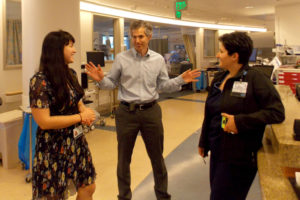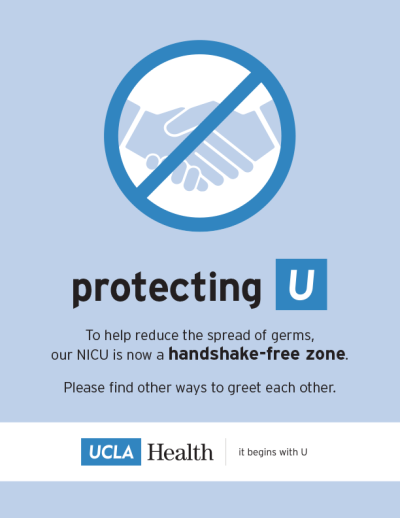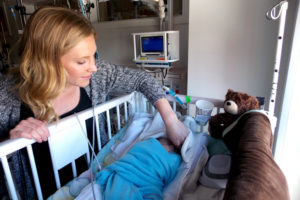Avoid handshakes in hospitals to prevent infections
Dr. Mark Sklansky, a self-described germaphobe, can’t stop thinking about how quickly those little microbes can spread.
“If I am at a computer terminal or using a phone or opening a door, I know my hands are now contaminated, and I need to be careful and I need to wash my hands,” said Sklansky, professor of pediatrics at the David Geffen School of Medicine at UCLA.
Not all health workers are so careful, despite strict hand-washing policies in virtually all medical facilities. A 2010 study published in the journal Infection Control & Hospital Epidemiology showed that only about 40 percent of doctors and other health care providers complied with hand hygiene rules in hospitals.
Handshake-free zones
Sklansky decided to test a new method at UCLA for limiting the spread of germs and reducing the transmission of disease: a handshake-free zone.
“We are trying to do everything to minimize hospital-acquired infection except for the most obvious and easiest thing to do in my opinion, which is to stop shaking hands,” he said.
Hospital-acquired infections are a serious and potentially life-threatening problem in hospitals, and the unwashed hands of health care workers are often to blame.
On any given day, 1 in 25 patients across the U.S. suffers from at least one infection acquired while they are in the hospital, according to the federal Centers for Disease Control and Prevention.

Neonatologist Joanna Parga, pediatric cardiologist Mark Sklansky and nurse Anahit Sarin-Gulian talk about the handshake-free zone while standing in the neonatal intensive care unit at Ronald Reagan UCLA Medical Center. They discouraged handshakes and suggested other options: a fist bump, a bow, a smile. The goal was to reduce the spread of germs and the transmission of infection. KHN/Anna Gorman
Sklansky first proposed the concept of handshake-free zones in a 2014 editorial published in the Journal of the American Medical Association. His proposal launched a debate about the possible risks of the time-honored greeting.
Six-month experiment
In 2015, Sklansky decided to try out the idea with a six-month experiment. He picked a place where patients are especially vulnerable — the neonatal intensive care unit. Infections among infants can cause them pain, prolong their stay in NICU, require more medications and even put them at risk of dying.
The anti-handshake experiment took place at two of UCLA’s NICUs, in Westwood and Santa Monica. Starting in 2015, Sklansky and his colleagues explained to the staff and families the purpose of handshake-free zones and posted signs designating the new zones. The signs feature two hands gripping each other inside a circle with a blue line through it, and the words: “To help reduce the spread of germs, our NICU is now a handshake-free zone. Please find other ways to greet each other.”
Options
They didn’t ban handshakes outright. They suggested other options: a fist bump. A smile. A bow. A wave. A non-contact Namaste gesture.
“We aren’t like a military operation,” Sklansky said. “We are just trying to limit the use of handshakes.”
This spring, Sklansky and his colleagues published the findings of a survey on their handshake-free zone experiment in the American Journal of Infection Control. They found that establishing such zones is possible, can reduce the frequency of handshakes and that most health care workers supported the idea. They didn’t measure whether avoiding handshakes actually reduced the rate of infections, but Sklansky said he hopes to answer that question in a future study.
Though the formal experiment is now over, the signs in the NICUs are still in place and doctors and nurses still discourage handshakes.
Avoiding handshakes is an effective way to decrease the spread of germs, said Maureen Shawn Kennedy, editor-in-chief of the American Journal of Nursing. Health care providers do wash their hands frequently, she said, but often they don’t do it for long enough or use the right technique. And bacteria live on computers, phones, medical charts and uniforms throughout hospitals, she noted.
“There are just so many reasons to avoid handshakes, even when people are washing their hands,” Kennedy said. “Just because someone is walking around in a white coat … doesn’t mean they don’t have bacteria on their hands.”
Although there is no data to prove that reducing handshakes limits hospital infections, one study showed that bumping fists was more hygienic than shaking hands.
Scrub better
However, some infectious-disease specialists believe health care workers don’t need to stop shaking hands. They just need to scrub better.
In a 2015 editorial in the Texas Heart Institute Journal, Herbert Fred, a Houston physician, wrote that “the problem isn’t the handshake: it’s the hand-shaker.” Doctors need to ensure their hands are clean before touching patients, he said.
Didier Pittet, an international expert on hand hygiene, said in an email that handshake-free zones are not the solution for hospital-acquired infections. They simply “reflect the lack of capacity in infection prevention and control,” he said.

Instead of a handshake, non-contact greetings like a bow, a wave, or a smile are encouraged. UCLA HEALTH
Sklansky agreed that hospitals need to improve compliance with hand hygiene, and he said handshake-free zones aren’t designed to replace hand-washing but to complement it. “I actually think handshake-free zones will bring attention to the hands as vectors for disease and help improve compliance with hand hygiene,” he said.
Neonatologist Joanna Parga, who was part of UCLA’s handshake-free survey, said she liked the idea when she first heard about it but wasn’t convinced it would work. Shaking hands is “so ingrained in our culture,” and it is how many doctors connect with patients, she said.
Parga said she has tried several alternatives to shaking hands, including bowing, making eye contact and touching people on the shoulder. She believes some of the other options are more intimate than a handshake — and they open up a conversation about safety. “Especially in a fragile patient population like the NICU, we really need to think about how we can protect our patients,” she said.
On a recent afternoon, as Parga walked through the Westwood NICU, she introduced herself to a mother who was holding her infant son.
“Hi. I’m Dr. Parga,” she said. “Are you Mom? I’m not gonna shake your hand. … It’s to help prevent infection in the NICU.”
Meena Garg, a neonatologist who is the medical director of the NICU in Westwood, said she still finds not shaking hands uncomfortable sometimes, because patients often extend their hands in greeting. “You feel like you are being rude,” she said.

New mom Brittney Scott said she’d never heard of a handshake-free zone and wasn’t sure about the idea. “But once you really understand the meaning behind it, it’s great,” she said. KHN/Anna Gorman
But Garg said she supports the handshake-free zone, because it is an easy — and inexpensive — way to reduce infections. “I am the medical director so I have to look at costs,” she said. “This doesn’t cost anything, but it may be just as important as anything else we do.”
Majority support
As part of the UCLA survey, Sklansky and his colleagues asked staff and parents what they thought of the new handshake-free zones.
The majority of health care workers supported the idea — especially medical school students and nurses. Male doctors were the most resistant to giving up the handshake, partly because they weren’t convinced it was necessary to prevent infections.
Families, however, were universally supportive of the handshake-free zone, Sklansky found.
On one recent day in the NICU, Brittney Scott stood beside the crib of her 2-week-old son, Samuel, as he slept. He had ended up there with intestinal problems.
Scott said she’d never heard of a handshake-free zone and had instinctively offered her hand to a doctor when she first arrived. She said she was “a little taken aback at first” when the doctor declined to take her hand. “But once you really understand the meaning behind it, it’s great.”
Scott knows Samuel is at risk of infection, so avoiding germs is critical. She said she now prefers a smile to a handshake.
“A smile goes a long way in here,” she said. “There’s a lot of ups and downs … being a parent to a NICU baby.”
KHN’s coverage in California is funded in part by Blue Shield of California Foundation.


